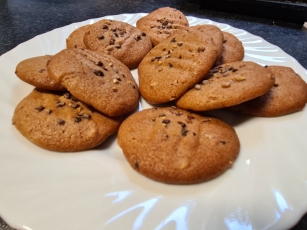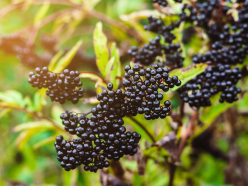
Foraging
The abundance of wild foods that grow quite naturally is quite astonishing.
Nettle tips, Ransome (wild garlic), wild onion, Dock, Dandelion, Sorell and Horseradish etc.the list is almost endless and this doesn't even include the fungi, the Birch sap,or the Beech and Hazel nuts.
Balsam seed biscuits, straight out of the oven
Many of our foraging plants look like weeds and would normally be dug out of most peoples gardens but they hold so many health benefits and flavours too, and all at our feet.
Rose willowherb, Ribwort Plantain, Garlic Mustard, Silverweed are just but a few; all grow naturally and just about everywhere too.
Acorns make an interesting 'coffee' and can be ground down to make flour for bread.
Even the invasive Himalayan Balsam has a place in our diet, the flowers are edible, the leaves are a great addition to a salad and Tegs has just baked us some delicious biscuits using the seeds
Root Crops
Big holes in the woodland canopy caused by the Ash dieback allow light to penetrate to the forest floor and its in these areas where we intend planting some rootcrops.
As an example, annually we eat about 150kg of potatoes which requires about 40 linear metres of planting and around 100 plants.
We eat about 30kg of carrots too, and these come from approximately 50 plants in a row of 4 linear metres
50kg of onions require a 5 linier metres and around 6 linear metres are need for spinach.
Fortunately, most crops only need the land for a season and thus two or more crops can be grown in the same strip; additionally, many crops like spinach don't have to be planted or harvested all at once and thus can provide fresh food for many months.
Fruit and nut trees
We have many varieties of Apple and Pear as well as Damson, Plum, Medlar and Cherry.
We also have the fruit trees that would be more associated with the woodland and these include Crab apple, Rowan and Elder; and the nut trees including Beech, Hazel and Sweet Chestnut
Elderberries

Fruit bushes
Strangely, many fruit bushes and shrubs grow naturally in Coed Glannant.
We believe there are two reasons for this, one is that seeds have been carried in bird droppings, and the other is that people have discarded waste (pips and cores etc.) and these have germinated.
So we are fortunate enough to have Gooseberrys, Raspberrys and Blackcurrents as well as an abundance of Bramble.and Bilberry.
We also have Sloe, Bullace, Hawthorn and Rosehip.
Many of these have been encouraged to populate the hedgerows which is often where we expect to find them.

